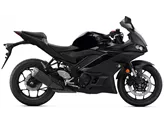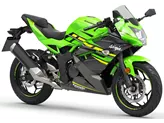Suzuki GSX-R 750 2015 vs. Yamaha YZF-R6 2017

Suzuki GSX-R 750 2015

Yamaha YZF-R6 2017
Vue d’ensemble - Suzuki GSX-R 750 2015 vs Yamaha YZF-R6 2017
The Suzuki GSX-R 750 2015 and the Yamaha YZF-R6 2017 are both supersport motorcycles that offer impressive performance and handling. However, there are some key differences between the two models.
In terms of engine specifications, the Suzuki GSX-R 750 2015 features a larger bore of 70 mm compared to the Yamaha YZF-R6 2017's 67 mm. This larger bore allows for a greater amount of air and fuel to enter the cylinders, resulting in a higher horsepower output of 150 HP compared to the Yamaha's 124 HP. The Suzuki also has a higher torque rating of 86.3 Nm compared to the Yamaha's 65.7 Nm. Additionally, the Suzuki has a slightly larger displacement of 749 ccm compared to the Yamaha's 599 ccm.
Both motorcycles feature a DOHC valve configuration and a four-cylinder engine layout, providing smooth and efficient power delivery. The Suzuki has a slightly higher compression ratio of 12.5 compared to the Yamaha's 13, which may result in slightly better performance and fuel efficiency.
In terms of chassis and frame, both motorcycles utilize an aluminum frame for lightweight and agile handling. However, the Suzuki features a Twin-Spar frame type, while the Yamaha utilizes a Deltabox frame type. The choice of frame type can affect the overall handling characteristics of the motorcycle, with the Twin-Spar frame providing a more balanced and stable feel, while the Deltabox frame may offer sharper and more precise handling.

Suzuki GSX-R 750 2015
Both motorcycles feature double disk brakes at the front, providing strong and reliable stopping power. The dimensions and weights of the front and rear tires are the same for both models, with a width of 120 mm and a diameter of 17 inches. The Suzuki has a slightly longer wheelbase of 1400 mm compared to the Yamaha's 1375 mm, which may result in slightly better stability at high speeds.
In terms of dimensions and weights, the Yamaha has a slightly higher seat height of 850 mm compared to the Suzuki's 810 mm. The Yamaha also has a slightly lower kerb weight of 189 kg compared to the Suzuki's 198 kg. Both motorcycles have a fuel tank capacity of 17 liters, allowing for decent range between refueling stops.
In terms of strengths, the Suzuki GSX-R 750 2015 offers excellent engine response and great controllability, making it a joy to ride. The comfortable seating position, even for tall riders, is also a plus. The Suzuki is known for its reliable technology and perfect transmission, ensuring a smooth and enjoyable riding experience.

Yamaha YZF-R6 2017
On the other hand, the Yamaha YZF-R6 2017 offers strong and direct brakes, providing confidence-inspiring stopping power. The sharp looks and high transparency of the Yamaha make it a head-turner on the road. The automatic gearshift is a convenient feature, allowing for seamless gear changes. The Yamaha also offers good wind protection, making it more comfortable for longer rides. The precise handling of the Yamaha ensures that it can tackle corners with ease.
In terms of weaknesses, the Suzuki GSX-R 750 2015 may not stand out among other motorcycles in terms of appearance, which may be a downside for some riders. The brake pads and lines of the Suzuki may not be suitable for racetrack use, requiring upgrades for optimal performance. The long final gear ratio of the Suzuki may also affect its acceleration and top speed.
The Yamaha YZF-R6 2017 has a more radical seating position, which may not be suitable for touring or long rides. The standard power output of 118.4 hp may be lower compared to other supersport motorcycles in its class, requiring additional upgrades for those seeking more performance. These upgrades can be cost-intensive, adding to the overall price of the motorcycle.
In conclusion, both the Suzuki GSX-R 750 2015 and the Yamaha YZF-R6 2017 are capable supersport motorcycles with their own strengths and weaknesses. The Suzuki offers excellent engine response and controllability, while the Yamaha boasts strong brakes and precise handling. Ultimately, the choice between the two models will depend on the rider's preferences and priorities.
Caractéristiques techniques Suzuki GSX-R 750 2015 par rapport à Yamaha YZF-R6 2017
Avantages et inconvénients en comparaison
Avantages et inconvénients en comparaison
Suzuki GSX-R 750 2015

La GSX-R 750 est à bien des égards le juste milieu. Elle offre le niveau de performance qui permet de ne pas être dépassé sur la route tout en ayant beaucoup de plaisir. D'un côté, elle est relativement bon marché, mais d'un autre côté, elle est toujours assez rapide. La GSX-R 750 est une superbe machine supersport. Ceux qui n'accordent pas d'importance aux superlatifs et souhaitent simplement avoir une bonne moto choisiront la GSX-R 750. Avec l'argent économisé, ils s'offriront ensuite des entraînements de course sur la Nordschleife....
Yamaha YZF-R6 2017

La Yamaha R6 2017 reste une moto supersport radicale tant sur le plan visuel que sur celui de la dynamique de conduite, l'une des meilleures et probablement la dernière du genre. La norme EURO4 coûte au quatre cylindres en ligne de 599 centimètres cubes avec soupapes en titane pas moins de 11 chevaux par rapport au modèle de 2007/2008. Mais Yamaha s'adresse clairement aux pilotes amateurs et professionnels sur circuit qui ne se soucient pas des performances de série. Avec plus de 50 accessoires, la R6 peut être améliorée en fonction des besoins et du budget. Mais chacun devrait être conscient que cela peut coûter cher.
Comparaison des prix Prix moyen du marché Suzuki GSX-R 750 vs Yamaha YZF-R6
There are a few key differences between a Suzuki GSX-R 750 2015 and a Yamaha YZF-R6 2017. It takes less time to sell a Suzuki GSX-R 750 with 95 days compared to 136 days for a Yamaha YZF-R6. Since model year 2005 1000PS.de editors have written 30 reviews for the Suzuki GSX-R 750 and 33 reviews for the Yamaha YZF-R6 since model year 2005. The first review for the Suzuki GSX-R 750 was published on 9/16/2003 and now has more than 4,000 views. This compares to more than 3,600 views for the first review on Yamaha YZF-R6 published on 10/17/2002.



















